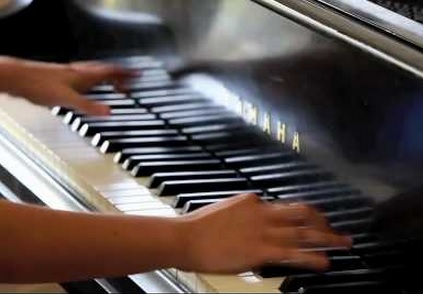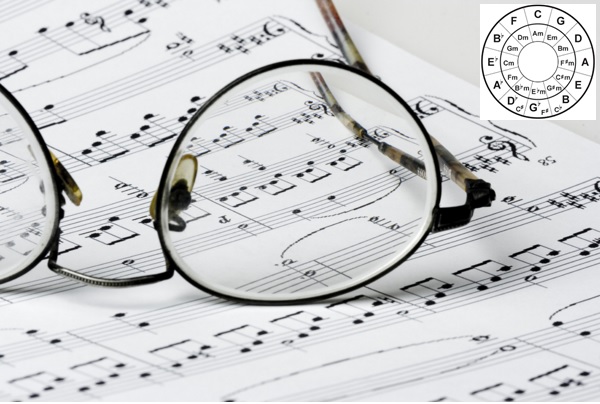
Sound like a pro, make your piano skills stand out with these tips, techniques, using these resources.
Playing the melody notes correctly and sticking to the rhythm is very important but piano techniques and tricks such as runs, riffs, accompaniment, scales, harmony, hand/finger independence, jumps, endurance and other techniques that will make your performance stand out.
This is where you will need to learn about piano techniques.
Good techniques will also help you to practice for longer sessions, reduce fatigue & prevent any sort of physical injury.
How to maintain the correct piano postureLearn to use the correct Piano Fingering
How To Play Piano Song
Here are practical tips and suggestions on how to learn to play piano songs quickly.
Break It Down
Break down a difficult song into smaller pieces. Try to play 8 bars or 16 bars at a time (you may even go for 4 bars of notes for most piano songs), depending on the size of the song. Once you are comfortable with one section, move onto the next set of bars. Finally, play through the entire song. Follow a similar approach when playing by ear.
Lower the Pace
If you encounter a passage which is difficult to play, try playing that passage at a lower tempo so that you can play it with the correct fingering. Stick to that passage until you are able to play it without any mistake at-least 3 consecutive times, only then proceed ahead to the next section.
Choose Songs CarefullyIf you’re unable to play a particular song with the above approach, you may not be ready yet to attempt that song. In that case, keep that music aside & pick up simpler songs for the piano, stick to your regular piano practice and attempt that song after a couple of months. So choose easy songs for piano initially!
How to Memorize Music Effectively
There are many performers who play without referring to written music. Even the ones who have the written music in front of them actually know the music thoroughly and can play it without the written music.
Memorizing music is an integral part of Learning Music. You need to follow a consistent process for memorizing all your songs.
You need to follow a solid memorization process so that you can consistently learn new pieces.
Break it Down
The best method is to break the piece down into various sections. Learn to say the notes aloud for each hand; learn to play each hand separately. Once comfortable, play both the hands together.
Using this approach (breaking down into pieces/sections), you can learn complex/lengthy pieces as well (which look daunting initially). Once the piece is memorized, you can work on expressions such as dynamics, articulations, and pedaling.

Look for Patterns
Try to look for patterns (musical phrases) in the music. Many a times, the piece of music may look very lengthy in the first place, but a closer look will reveal that several patterns are getting repeated throughout the piece.
If there are lots of repeating patterns, it work to your advantage, because once you memorize a phrase or section, you just have to recall it from memory the next time you encounter it.
Note: In some cases, the phrase or section may start on a different note/key (known as modulation), which is also comparatively easier to learn.
Get it right three times in a row
My music teacher suggested I use this technique, more as a memorizing tool for practicing. If you can play a piece three times in a row without any mistakes, then it means you know it pretty well.
Note that counting, fingering, notes, pauses, everything should be right in your performance (that qualifies as a performance without mistakes).
That is only possible with practice; you cannot expect improvement if you are not going to practice. And the same goes for memorizing as well; the more you practice, the better your brain will remember. Make sure, you focus on the dynamics as well while practicing.
Expressions & Embellishments
Articulations
These are symbols which tell you things like whether you need to play the notes louder or softer, shorter or longer, whether you need to play additional notes and so on.
Without articulations, any song would sound monotonous and will become boring to hear. The Piano keys themselves are touch sensitive, meaning the sound they produce depends on how hard or soft we press the keys.
Articulations tell the players to use this ability of the piano.
Grace Notes
By definition, a grace note is a note/set of notes that you play immediately before the main note.
You quickly move/slide through the grace notes before you come to the note that is intended to be played. Normally the grace notes are half-step or whole-step away from the main note.
Grace notes are easy to play but it sounds a bit complex to the ears; that is why you should use them. Besides, you will need to use this piano technique while playing blues/jazz.
Here are some of the best Books on Piano Technique- Burgmller, Czerny & Hanon — Piano Studies Selected for Technique and Musicality, Vol 1
- Famous Pianists and Their Technique
- What Every Pianist Needs to Know About the Body
- The Piano Handbook: A Complete Guide for Mastering Piano
- Piano Technique Demystified
- Virtuoso Piano Technique
- How to Play the Piano Despite Years of Lessons
Trills/Tremolos
A trill tells you to play two notes in rapid succession giving a fluttering effect.
The notes are normally half-step or whole-step away from each other. Tremolos on the other hand, have the two notes more than a whole-step apart.
You can even add a tremolo effect to chords; a perfect example would be rock-n-roll where tremolo chords are commonly used.
Gliss
A Gliss is short for Glissando. Here you slide your fingers quickly across many keys on the keyboard.
Though, this effect has been used in many rock-n-roll songs, you can use it in any fast paced song; it will surely dazzle your audience.
This piano technique is also a hit with kids but you need to know the correct way to do it, which is with your finger nails… else you will surely hurt your fingers.
Note – So go back to work and start practicing these new tricks. I am sure you are going to find these piano techniques interesting, as they are fun to work with.
Besides, some of these tricks can be used to cover for your mistakes as well. Yes, the wrong notes that everybody plays sometimes or the other.
With practice, you can almost every time change the wrong note to a grace note or trill to arrive at the correct note.
Chords & Songs
Every beginner wants to play songs effortlessly on the piano, and embellish them with interesting chords, or just impress the audience with riffs & licks.
That is why all those finger exercises & technique books (czerny, Hanon) are so useful.
Here are some useful links on how to improve your piano playing technique. If you feel like you’re stuck in a rut with your piano playing, these tips can help you out.
- Learn how to play piano songs
- Learn to use piano chords in different ways
- Piano Accompaniment – How do you accompany someone?
Learn How to Play Piano Riffs / Licks
A piano Riff / Lick is a repeated chord progression, melodic phrase, music pattern, or amazing “musical runs / short passages”, and can be used as part of the accompaniment or as part of solo playing or as fillers between songs. They are not recognizable melodies as such and are basically used more as a decoration tool on the overall song.
It is a handy tool to have in your repository since it easily impresses people who happen to be listening to you. If you are playing in a band, it is even more important to be able to play piano riffs; you can use them during breaks or you can use them for your solo part.
You also get books on how to play riffs on the piano. Although these books can be used by beginners, most of them are suitable for intermediate level piano players. With these books, you can learn intros and endings suitable for use in gigs, smooth-sounding progressions for fill-ins, and simple to more complex chord progressions.
How to Improvise on the Piano | Keyboard Lessons
When you begin learning to play the keyboards/piano, most of the time, you play from a written piece of music; you play the right and left hand note-by-note.
Improvisation is introducing variation in your playing, especially with the left hand, which is used for accompanying the right hand (melody notes), although as you become better at it you can improvise using both the hands.
Improvisation is a nice way to provide some rhythmic movement to your piano solo.
Here are some videos that show you how to improvise on the keyboard.
How to Harmonize Melodies on the Piano
Playing the same chords after some time can be boring, and it can also sound dull repetitive after some time. That is why most pianists try to improvise; though it is another thing that most also try to show-off, but the fact is that you can make your playing sound fresh by using proper chord substitutions.
To begin with you can use just the primary chords. For example, if you’re playing the song on the C scale then you can use the C, F and the G major chords to harmonize. Together, these three chords cover all the notes of the C major scale.
There are times when you let your ears be the judge and not follow any rules rigidly. For example, if the melody line contains G E G A C, then the C major chord on its own should be sufficient to go along with the melody notes.
You can always try to improvise to prevent it from sounding monotonous. Here are a couple of things you can do to make it more interesting.
- Use different inversions of the C chord while playing.
- Occasionally use the chord F to harmonize the C note to make it a bit interesting. Of course, you should do this in the middle of the song, as the song usually ends with a chord that is based on the key of the song (in this case, the C chord if the song is based on the C scale)
Here’s another example: use relative minors of the major chords.
So, for example, instead of the chord C you can choose to play the relative minor of chord C, which is “A minor”. So you can use “A minor”, as long as the melody tolerates it and doesn’t seem to be really out of place.
Another example, albeit a bit difficult to play, involves using four notes chords. Here you can replace a “seventh chord” with a “minor seventh”. For example, you can substitute C7 (dominant seventh cord) with Gm7 (minor seventh).
You can also use the sixth chord, instead of playing just the major chord. So C6 instead of just the C chord.
So use these techniques to harmonize on the piano.
How to Play Piano / Keyboard and Sing at the Same Time
Here are some reasons to acquire this skill – playing the piano or keyboard and singing.
- It’s fun to sing and you become a complete musician.
- It increases your demand as a performer.

Sing and Play Separately at First
Remember those days when you were struggling to use both your hands together? You do the same here as well – learn them separately.
Start by singing a cappella (without any instruments) and then work your way to singing along with a pre-recorded piano track. You can then play few simple chords while you focus on your singing technique.
Now, switch the focus to your piano playing, while singing quietly. Once you’re confident with the keys, gradually start combining the two.
Start Early
If you have recently started taking piano lessons, then a good habit to develop is to sing along whatever you play on the piano. You may choose to hum or sing the actual words of the song, but just do it. You never know, you may have a hidden skill which you might uncover.
Leave a Reply